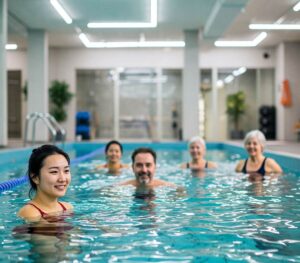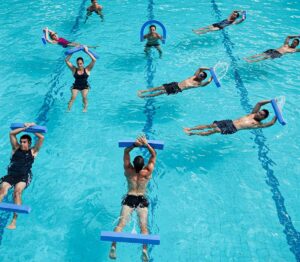The concept of gym pools has gained considerable attention in recent years as more fitness facilities incorporate aquatic amenities into their offerings. Traditionally perceived as leisure spaces, gym pools are increasingly recognized for their versatility and potential to enhance physical wellbeing. These facilities not only provide a refreshing escape from regular workouts but also serve as valuable resources for individuals aiming to incorporate water-based exercises into their fitness routines.
Utilizing a gym pool can significantly contribute to overall health and wellness. Water workouts can be particularly beneficial for individuals of all fitness levels, from beginners to seasoned athletes. The buoyancy of water relieves stress on joints and muscles, making it an ideal environment for rehabilitation, low-impact workouts, or even high-intensity training. This unique setting allows individuals to perform various exercises such as swimming, water aerobics, and resistance training, effectively broadening their workout options.
Moreover, gym pools provide a conducive atmosphere for cardiovascular and strength training exercises alike. Engaging in swimming or water jogging can elevate heart rates and improve stamina while also building muscle strength and endurance. This multifaceted approach to fitness emphasizes the importance of water as a critical component of a comprehensive workout strategy, leading to improved overall health outcomes.
Additionally, the rising popularity of gym pools can be attributed to the shifting perceptions surrounding fitness. With an increased awareness of the mental and physical benefits associated with aquatic exercises, individuals are more willing to explore this innovative approach to fitness. As gym pools evolve to accommodate various programming, they are becoming indispensable in the pursuit of a balanced and holistic approach to health and well-being.
Reason 1: Low-Impact Exercise
One of the most significant benefits of using the pool at your gym for exercise is the low-impact nature of aquatic workouts. Unlike traditional workouts performed on solid ground, water provides a buoyant environment that effectively reduces the strain on joints. This property makes swimming and water aerobics suitable options for individuals with injuries, arthritis, or those who may be recovering from surgery. As the body is submerged in water, buoyancy supports a considerable portion of body weight, minimizing stress on essential joints such as the knees and hips.
Engaging in low-impact exercises within a pool can enhance mobility and promote flexibility, making it an excellent choice for both fitness enthusiasts and individuals easing into a new workout routine. The freedom of movement that water provides encourages participants to perform a variety of motions without the fear of injuring themselves. Therefore, water-based exercises can keep individuals active while minimizing the risk of setbacks often associated with higher-impact activities.
Moreover, low-impact workouts in the pool can effectively cater to diverse fitness levels. Beginners can gain confidence and comfort while building their strength and endurance, while more experienced exercisers can increase intensity through resistance provided by the water. By incorporating elements such as kickboards, resistance bands, or water weights, one can effectively vary workouts and further challenge the body without succumbing to excessive stress. The versatility of aquatic exercise makes it an approachable option for those hesitant about starting a fitness journey or overcoming physical limitations.
In sum, utilizing your gym’s pool for exercise offers a safe, effective, and enjoyable way to stay active while minimizing the risks of joint strain and injury.
Full-Body Workouts
One of the primary advantages of using the pool at your gym is the opportunity to engage in full-body workouts that effectively target multiple muscle groups. Swimming and various water-based exercises provide an excellent way to achieve comprehensive fitness while minimizing the risk of injury. The buoyancy of water reduces the impact on joints, making these activities suitable for individuals of all fitness levels, including those recovering from injuries.
Swimming laps is a fundamental exercise that promotes cardiovascular health and muscle development. As you glide through the water, you activate a range of muscle groups including the shoulders, arms, core, and legs. Each stroke requires coordination and strength, leading to improved muscular endurance and overall fitness. For instance, the freestyle stroke primarily engages the upper body while incorporating the core and lower extremities, resulting in a synergistic workout that enhances strength and stamina.
Aqua aerobics is another effective pool exercise that has gained popularity due to its versatility. Classes typically involve a variety of movements set to music, using resistance equipment such as foam dumbbells or noodles to increase the intensity. This type of workout enhances strength, flexibility, and cardiovascular fitness. The resistance of the water helps tone muscles, while simultaneously providing a low-impact alternative to traditional gym workouts, making it particularly appealing for those with joint concerns.
In addition to swimming and aqua aerobics, there are other water-based activities to consider. Water jogging or swimming intervals can elevate your heart rate while offering a full-body resistance workout. Incorporating these exercises into your routine not only builds muscle but also boosts endurance and flexibility, making the pool a prime location for achieving holistic fitness goals.
Cooling Off While Burning Calories
Exercising in a pool presents a unique opportunity to enhance your workout experience through temperature regulation. When engaging in physical activity, maintaining a comfortable body temperature is crucial for performance and endurance. Water possesses a remarkable ability to cool the body, enabling individuals to train harder and for longer periods without experiencing overheating. This cooling effect is especially beneficial during hot weather or for those who may struggle with overheating during traditional workouts.
The temperature of the water plays an important role in promoting an effective workout regime. Cooler water can help moderate the body’s core temperature, allowing individuals to focus on pushing their limits. As a result, workouts can become significantly more comfortable, leading to an increase in overall workout duration and intensity. This can be particularly beneficial for individuals participating in high-energy aquatic exercises such as water aerobics, swimming laps, or performing resistance training with aquatic equipment.
Moreover, exercising in water can reduce the impact on joints, making it a safer option for individuals recovering from injuries or dealing with conditions such as arthritis. This ease of movement, combined with the cooling benefit of being submerged in water, can encourage individuals to engage in workouts that they might otherwise avoid due to discomfort or fear of overheating.
Incorporating pool exercises into your fitness routine not only enhances calorie burning but also provides a refreshing escape from traditional gym environments. Therefore, for anyone looking to diversify their workout regimen while efficiently managing their body temperature, taking advantage of the gym’s pool facilities should be a top consideration.
Reason 4: Stress Relief and Mental Health Benefits
Engaging in water-based activities such as swimming not only provides physical fitness but also significantly contributes to mental health and stress relief. The soothing properties of water have long been recognized for their calming effects on the body and mind. When individuals immerse themselves in a swimming pool, they often experience a sense of weightlessness and freedom, which can alleviate feelings of anxiety and tension. The relaxation response triggered by being in water can lower cortisol levels, the hormone associated with stress, thereby promoting an overall sense of tranquility.
Moreover, the rhythmic nature of swimming mimics mindfulness practices such as meditation. As swimmers focus on their breathing and the repetitive strokes of their arms and legs, they inadvertently enter a state of flow. This mental state fosters enhanced concentration and an escape from daily worry, allowing individuals to center their thoughts and experience a meditative-like tranquility. The absorbed experience within the water can drown out external stresses, promoting emotional well-being as individuals focus solely on their movements and the sensation of being in water.
In addition, swimming can serve as a social activity that strengthens community bonds and fosters support. Many gyms offer group swimming classes where participants engage with others who share similar fitness goals. This interaction not only promotes social connectivity but can also serve as an outlet for sharing experiences and support, further enhancing mental health resilience. Swimmers often report feeling more relaxed and uplifted after their time in the pool, illustrating the instrumental role that water exercise plays in managing stress and improving emotional health. Overall, utilizing the pool at your gym can be a significant contributor to maintaining a balanced and healthy mind.
Social Opportunities and Community
The pool at your gym is not merely a space for physical exercise; it serves as a vibrant social hub that can enhance your overall fitness journey. Engaging in activities at the pool, such as group swimming classes or water aerobics, allows members to foster connections that extend beyond mere workouts. These communal activities promote interaction and create a supportive environment, encouraging individuals to pursue their fitness goals together.
Participating in group classes helps cultivate a sense of community among gym-goers. When people swim together or take part in water aerobics, they share similar challenges and triumphs. This shared experience not only motivates participants to challenge themselves but also instills a sense of accountability, as members often encourage one another to stay committed to their fitness routines. The camaraderie developed in these classes can lead to lasting friendships that enrich the overall gym experience.
Moreover, the social opportunities presented by gym pools are not limited to classes. Many gyms offer swim clubs or social swim hours, where members can meet casually, socialize, and enjoy recreational swimming. These informal gatherings can help alleviate the isolation that sometimes accompanies gym activities, transforming the workout experience from a solitary endeavor into a spirited and enjoyable one.
The pool acts as a melting pot for diverse individuals, from seasoned swimmers to beginners, fostering an inclusive atmosphere. This diversity not only enriches the learning experience for new swimmers but also creates an environment where experienced members can offer guidance, making the fitness journey less daunting. In essence, the gym pool promotes a community-centric approach to fitness that encourages collaboration, motivation, and lasting connections among members.
How to Incorporate Pool Activities into Your Routine
Integrating pool activities into a regular fitness plan can enhance overall health and provide a refreshing change from traditional workouts. To start, it is essential to schedule specific days dedicated to pool sessions. By allocating consistent days each week for swimming, individuals can easily develop a routine that allows them to enjoy the benefits of this low-impact exercise. For instance, setting aside two or three days per week for swimming can make it a staple in one’s fitness regimen.
Combining swimming with other forms of exercise is another effective strategy to maximize workout efficiency. Consider alternating days between pool workouts and other activities such as strength training, cycling, or group fitness classes. This approach not only maintains variety in your workouts but also helps target different muscle groups, preventing monotony and potential plateaus in progress. You might swim in the pool on certain days and follow it up with a weightlifting session or a brisk walk on land to balance your fitness routine.
Furthermore, establishing realistic goals can significantly contribute to maintaining motivation. Start by setting attainable targets such as swimming a specific number of laps, improving stroke technique, or increasing lap time durations. These objectives should be challenging yet achievable, providing a sense of accomplishment as they are met. Keep track of progress to evaluate improvements and adjust your goals when necessary, which helps foster a growth mindset and continues engagement in pool activities.
To further stay motivated, consider joining group swim classes or enlisting a workout buddy. Engaging with others not only builds accountability but can also make workouts more enjoyable. As you incorporate these tips into your routine, you will likely discover newfound enthusiasm for using the pool as an integral part of your fitness journey.
Safety Considerations When Using Gym Pools
When it comes to utilizing the pool at your gym, safety should always be a top priority. Gyms generally implement specific pool rules designed to maintain a safe environment for all users. It is vital to familiarize yourself with these guidelines before entering the water. Understanding prohibitions, such as running on the pool deck, diving in shallow areas, and any unique rules established by the facility, can significantly reduce the risk of accidents or injuries. Ignoring these regulations not only puts yourself at risk but also endangers fellow swimmers.
Another critical aspect of safety is the importance of supervised swimming. Many gyms provide lifeguards or trained staff to oversee pool activities. Their presence serves not only to assist in emergencies but also to ensure compliance with pool rules. Even for seasoned swimmers, the unexpected can occur, making supervision essential for all participants. Adhering to designated swim times, particularly during peak hours, can help ensure that users swim in a controlled environment where assistance is readily available if needed.
Furthermore, practicing proper hygiene is paramount to enjoying a safe and healthy swimming experience. Users should shower before entering the pool and avoid pool use if they are unwell or have skin infections. This practice helps to prevent the spread of bacteria and contaminants that could adversely affect the quality of the water and the health of those swimming. Additionally, many gyms provide guidelines on swimwear and accessories allowed in the pool, which are also designed to maintain clean and safe conditions for all users.
By adhering to pool rules, swimming under supervision, and prioritizing hygiene, gym-goers can contribute to a safe swimming environment that enhances the enjoyment of everyone involved.
Conclusion: Making the Most of Your Gym Pool
Incorporating swimming into your fitness routine can offer numerous benefits that align neatly with your overall wellness goals. As we’ve explored in this blog post, the gym pool serves as an excellent environment for achieving low-impact workout efficiency, promoting joint health, and enhancing cardiovascular fitness. By utilizing the pool facilities available at your gym, you can diversify your workout regimen and introduce refreshing variations that are both enjoyable and effective.
Engaging in aquatic exercises not only builds strength but also improves flexibility and mental well-being. The water’s buoyancy provides a supportive atmosphere, which is particularly advantageous for individuals recovering from injuries or for those seeking to minimize strain on their bodies. Moreover, swimming is a full-body workout that targets multiple muscle groups simultaneously, making it a time-efficient choice for busy individuals aiming to maximize their results.
Furthermore, the calming effects of being in water can significantly reduce stress and enhance mood, contributing to overall mental health. This aspect is often overlooked but is equally important in a well-rounded fitness journey. With the variety of classes and activities typically offered in gym pools, from aqua aerobics to lap swimming, there is something suited to every fitness level and preference.
Therefore, it is highly advisable to consider making the gym pool a regular part of your exercise schedule. Embrace the numerous advantages it offers for both physical and mental health, and view it as an opportunity to enrich your fitness regimen. In conclusion, by utilizing the resources of your gym’s pool, you are taking a proactive step towards enhancing your overall health and achieving your wellness goals.



